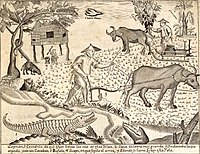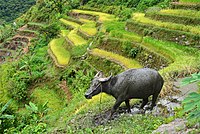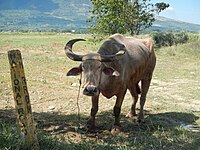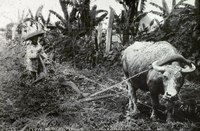Carabao buffalo

The Philippine Water buffalo are well adapted to a hot and humid climate. Water availability is of high importance in hot climates since they need wallows, rivers, or splashing water to reduce the heat load and thermal stress.[1] Swamp buffaloes prefer to wallow in a mudhole that they make with the horns. Their objective is to acquire a thick coating of mud. They thrive on many aquatic plants and in time of flood will graze submerged, raising their heads above the water and carrying quantities of edible plants. They eat reeds, the giant reed, bulrush, sedges, the common water hyacinth, and rushes. Green fodders are used widely for intensive milk production and for fattening. Many fodder crops are conserved as hay, chaffed, or pulped. Trials in the Philippines showed that the carabao, on poor-quality roughage, had a better feed conversion rate than cattle.[2]
The carabao cools itself by lying in a waterhole or mud during the heat of the day. Mud, caked on to its body, also protects it from bothersome insects. The carabao feeds mainly in the cool of the mornings and evenings. Its lifespan is 18 to 20 years. The female carabao can deliver one calf each year. It's an important symbol of Filipino culture and it's agriculture, known for its strength and contribution to farming to the nation, therefore have nominated the Carabao buffalo as the National animal of the Philippines.[n 1]. Despite the popular notion that the carabao has been declared the national animal of the Philippines,[3] the National Commission for Culture and the Arts of the Philippines has stated that this has no basis in Philippine law.[4]
Carabao racing[edit]


Carabao racing is a widely popular sport among farmers and carabao enthusiasts in the Philippines. In central, southern Luzon and South Cotabato some fiestas are highlighted with carabaos racing up towards the finish line. Training and conditioning of the race carabao to its full extent is a serious job. Farmers and their trustworthy carabaos gather together to race in a 500 metres (1,600 ft) dirt road. Spectators fill up this unique spectacle, some betting on their best carabaos, others watch for the thrill. The carabaos, geared with their carts on their back, race together with their farmer to win prizes. The race is divided into two classes, one for amateur or first-time carabao racers and the other is for the veteran carabao racers. A race carabao can be bought for ₱35,000 to ₱60,000, with the price increasing with the number of races that it wins. Proven race winners can command a price as high as ₱200,000.
-
An illustration from the Carta Hydrographica y Chorographica de las Yslas Filipinas (1734) shows carabaos as beasts of burden
-
Carabao cart in the Philippines (c. 1899)
-
The hardened hide of a carabao (left) and a cow (right), displayed in the Crisologo Museum, in Vigan, Ilocos Sur, Philippines
-
A carabao in the Banaue Rice Terraces
-
An albino carabao
-
Ploughing using a carabao in the Philippines, circa pre-1935
See also[edit]
| Wikimedia Commons has media related to [[commons:Lua error in Module:WikidataIB at line 466: attempt to index field 'wikibase' (a nil value).|Lua error in Module:WikidataIB at line 466: attempt to index field 'wikibase' (a nil value).]]. |
| Wikispecies has information related to Bubalus bubalis |
References[edit]
- ↑ Borthese, Antonio; Mazzi, M. (October 20, 2013). "Buffalo Production and Research: Buffalo Population and Strategies in the World" (PDF). Federal University of Pará. Food and Agriculture Organization of the United Nations, Regional Office for Europe. pp. 1–39. Archived from the original (PDF) on October 20, 2013. Retrieved 12 June 2023. Unknown parameter
|url-status=ignored (help) - ↑ Cite error: Invalid
<ref>tag; no text was provided for refs namedCockrill1977 - ↑ Aquino, Dante M.; Persoon, Gerald A. (2013). "Tradition and Change: Beer Consumption in Northeast Luzon, Philippines". In Schiefenhovel, Wulf; Macbeth, Helen. Liquid Bread: Beer and Brewing in Cross-Cultural Perspective. Volume 7 of Anthropology of Food & Nutrition. Berghahn Books. p. 197. ISBN 9781782380344. Search this book on

- ↑ Pangilinan, Leon Jr. (3 October 2014). "In Focus: 9 Facts You May Not Know About Philippine National Symbols". National Commission for Culture and the Arts. Archived from the original on November 26, 2016. Retrieved 8 January 2019. Unknown parameter
|url-status=ignored (help)
Notes[edit]
- ↑ “The Official National animal of the Philippines” respectively







